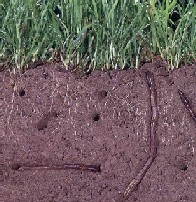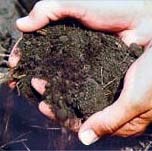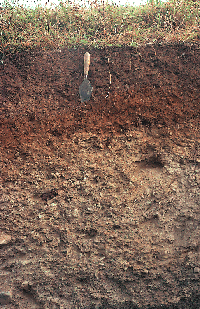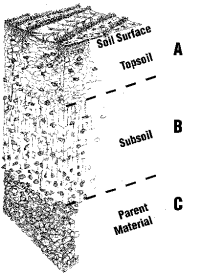What is Soil?
Soil is one of the three major natural resources, alongside air and water. It is one of the marvellous products of nature and without which there would be no life.
Soil is made up of three main components – minerals that come from rocks below or nearby, organic matter which is the remains of plants and animals that use the soil, and the living organisms that reside in the soil.
The proportion of each of these is important in determining the type of soil that is present. But other factors such as climate, vegetation, time, the surrounding terrain, and even human activities (eg. farming, grazing, gardening etc.), are also important in influencing how soil is formed and the types of soil that occur in a particular landscape.
Soil can form from the rocks below, or from rocks a very long distance away - perhaps being carried by wind or water. The glaciers of the last ice age acted as giant bulldozers pushing truly huge amounts of soil along as they grew and dropping the soil as they melted.
|  | |
Have you ever noticed the different textures in soils? Rub some soil between your finger and thumb to see. Try this in different areas as a comparison.
Textures come mainly from the size and amount of mineral particles present in the soil. For example, if you try picking up a handful of a sandy soil, you will notice that it feels ‘gritty’. This is because it is made up of large mineral particles. Compare this to a handful of clay soil, which feels sticky to touch when wet because it has finer particles which can hold more water. Silty soils lie in composition between sandy and clayey ones and have a smooth somewhat velvety feel to them.
Organic matter, also called humus, believed by many to be the most important constituent of soils, is partially-decomposed organic material, rich in nutrients, which is essential to the fertility of soil (or how fruitful and productive it is). You can often tell how much organic matter there is in soil by looking at how dark it is – the darker the soil, the greater the concentration of organic matter.
|  | ||
The Soil Profile
When most people think of soil, they generally tend to consider only the surface of the land. In fact, this is only the topsoil. Soil may go down several metres before solid rock is reached. There are actually three main layers in most soils (referred to as horizons). These are the topsoil, subsoil and then the parent material.
 | |||
The nature of soils varies according to geographical location, climate, etc. However, the topsoil will often be dark brown or black in colour (though not in very arid or dry areas), and is made up of rock material that has been chemically and physically broken down and changed, and mixed with organic materials such as dead plants, particularly roots of them. Furthermore, it will generally be full of plant and animal life.
The subsoil also consists of altered rock material, but contains much less plant life (mainly roots) and living creatures. However, minerals can be broken down, and nutrients released from this layer for use by roots of plants.
Finally, the parent material is located at the very bottom, usually below half a metre and consists mostly of unaltered rock or glacial deposits, the matter from which the soil is developed.

No comments:
Post a Comment